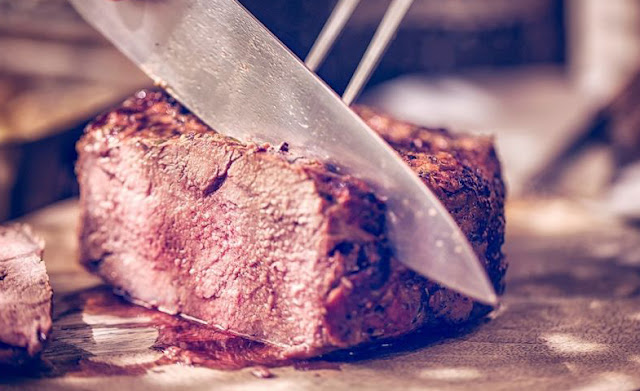Eight ways to make hard meat more tender
 |
| Eight ways to make hard meat more tender |
I think we've all been there: another formula or a new cut of meat abandons us with an intense, chewy feast. It feels inefficient and it can be truly humiliating in the event that it occurs amid a supper party. So what's the reason, and how would you make extreme meat delicate?
Indeed, softening meat isn't as troublesome as you may think! With a couple of traps, similar to the one's we have underneath, you can have even spending plan agreeable and new cuts super delicate with only some additional exertion. Discover how underneath, and bear in mind to get some information about these cuts.
1. Physically tenderize the meat
For intense cuts like hurl steak, a meat hammer can be a shockingly successful approach to separate those extreme muscle strands. You would prefer not to pound it into insensibility and transform the meat into mush, yet a light beating with the unpleasant edge of a meat hammer will do the trap. On the off chance that you don't have one, you can delicately score the surface in a crosshatch design with a blade or utilize a fork to jab little openings into the meat.
2. Use a marinade
Cuts like flank or skirt steak make magnificent barbecuing steaks, however they're so extreme you won't have any desire to eat them without a little marinade activity. Utilizing acidic fixings like lemon juice, vinegar or buttermilk include enhance as well as separate intense proteins, giving the meat a "pre-cook" before it hits the flame broil. Simply ensure you don't give it a chance to sit on the marinade for a really long time (30 minutes to two hours ought to be adequate), or it'll turn out to be delicate and soft.
3. Don’t forget the salt
Regardless of whether you're marinating or not, in any event make a point to salt the meat before cooking. Salt draws out dampness from inside the meat, thinking the flavors and making a characteristic brackish water. You know it's working on the grounds that the meat will go up against a more profound, red shading. Not at all like marinades, you can salt your meat for up to 24 hours.
4. Let it come up to room temperature
This is particularly critical with grass-nourished hamburger and other lean cuts of meat. Since there's not a great deal of fat on these cuts, they're less lenient if marginally overcooked. Giving the meat a chance to sit on a room temperature counter for 30 minutes before cooking will enable it to cook all the more equitably.
5. Cook it low-and-slow
More costly cuts of meat can be streak burned over high temperatures, however numerous spending cuts, similar to pork shoulder or hurl broil, require low-and-moderate cooking procedures (like these moderate cooker sandwiches). When braising extreme cuts of meat, the collagen separates in the cooking fluid and truly gives those intense muscle filaments a chance to isolated. Ensure you give yourself enough time to give those chops a chance to separate, which could take at least four hours in a Dutch stove or moderate cooker.
6. Hit the right internal temperature
Overcooking can make your meat dry yet undercooked meat can be very chewy. Try not to fear a moment read meat thermometer and draw your meat when it's prepared. For normally delicate cuts like meat tenderloin, that can be as uncommon as 125ºF, though harder cuts like brisket ought to be cooked to 195ºF.
7. Rest your meat
Regardless of how well you get ready and cook your meat, it will turn out dry and intense in the event that you don't give it a chance to rest. A general dependable guideline is five minutes for each inch of thickness for steaks, or ten minutes for every pound for broils. This enables the juices to redistribute inside the meat as opposed to spilling out onto the cutting board—that implies your meat will be dry and extreme.
8. Slice against the grain
All cuts of meat have long muscle strands that keep running all through them. On the off chance that you make slices parallel to the muscle filaments, you'll wind up utilizing your teeth to get through them as you bite. That sounds like an exercise! Rather, cut transversely against the muscle filaments so they fall to pieces effectively and easily.
Try these tips to make hard meat more tender.







No comments:
Post a Comment